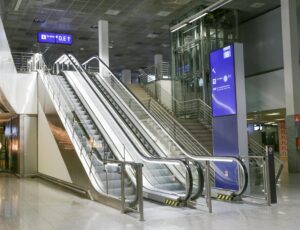Lift & Escalator and Conveyor Belts : MEP’s Role in Contemporary Construction

In today’s fast-paced world, the seamless movement of people and materials is vital in both commercial and industrial spaces . Technologies like lifts, escalators, and conveyor belts are central to ensuring efficiency and safety in buildings and production facilities. But beyond their mechanical functionality, their integration into a building relies heavily on MEP construction and MEP services, ensuring that these systems operate smoothly within the broader architectural and engineering framework.
Why MEP Services Are Essential for Lifts & Escalators
MEP refers to Mechanical, Electrical, and Plumbing. When applied to construction, MEP in engineering deals with the design and fitting of systems that bring buildings to life, make them comfortable, and ensure their safety. Elevators, escalators, and conveyor belts, though usually regarded as mechanical systems, need a careful MEP civil engineering solution for their implementation.
Mechanical: Pertains to the installation, installation, and maintenance of moving parts like lift motors, escalator drives, and conveyor belt mechanisms.
Electrical: Includes the power supply, control, and automation necessary for these systems to function reliably.
Plumbing: Although not necessarily directly related, plumbing can overlap with lifts and escalators in applications for fire protection systems, water drain, or HVAC integration within building shafts.
Role of MEP Construction in Conveyor Belts
Lifts and escalators are more than vertical and horizontal transportation devices—they are very important parts of building design.
Important Considerations in MEP Services
1. Mechanical Design : Lift shafts, escalator slopes, load-bearing capacities, and safety devices are designed to satisfy operational as well as regulatory demands.
2. Electrical Integration : Power distribution, backup power generators, sensors, and illumination are all included in the electrical planning. Sophisticated MEP in engineering guarantees a minimum of downtime and energy efficiency.
3. Civil & Structural Coordination : Shafts construction, floor leveling, and integration into HVAC and fire protection systems are imperative. This is where MEP civil engineering knowledge provides smooth integration without compromising structure.
Proper MEP construction ensures that these systems not only work but also conserve energy and are safe for users.
Conveyor Belts : Streamlining Industrial and Commercial Operations
Conveyor belts play a critical role in material handling in industries, warehouses, and airports. With the inclusion of MEP services, the conveyor belts operate smoothly and live long.
MEP Factors to Consider with Conveyor Belts
Mechanical : Choosing the type of belt, motor size, and speed control in relation to load demand.
Electrical : Motor drive and control panel, sensor, and emergency stop installation.
Plumbing & Environmental Systems : Effective drainage, cleaning systems, and HVAC factors if conveyor belts are located in temperature-controlled or dusty areas.
Integrating MEP in engineering design guarantees conveyor systems are efficient, safe, and compatible with other building systems.
Why MEP Services Are So Important for Lifts, Escalators, and Conveyor Belts
1. Efficiency : Adequate mechanical and electrical planning minimizes energy consumption and downtime.
2. Safety : Combining fire safety, emergency evacuation, and backup power systems ensures safety compliance.
3. Longevity : On-going MEP maintenance planning extends the life of mechanical systems.
4. Coordination : MEP civil engineering coordinates all the parts to function in concert within the architectural structure.
Conclusion
The MEP construction and MEP services‘ part in fitting and maintaining conveyor belts, escalators, and lifts cannot be overemphasized. Right from mechanical design to electrical integration and civil coordination, all phases ensure that such systems are efficient and safe. For engineers, architects, and building owners, adopting end-to-end MEP planning is the secret to a successful and sustainable infrastructure.
Lifts, escalators, and conveyor belts are vital for smooth movement in contemporary buildings and industrial premises. Their smooth running has much to do with MEP construction and MEP services, bringing together mechanical, electrical, and plumbing systems within the building’s design. From providing energy efficiency and safety to coordinating with civil structures, MEP in engineering is crucial in making such systems efficient and long-lasting.


